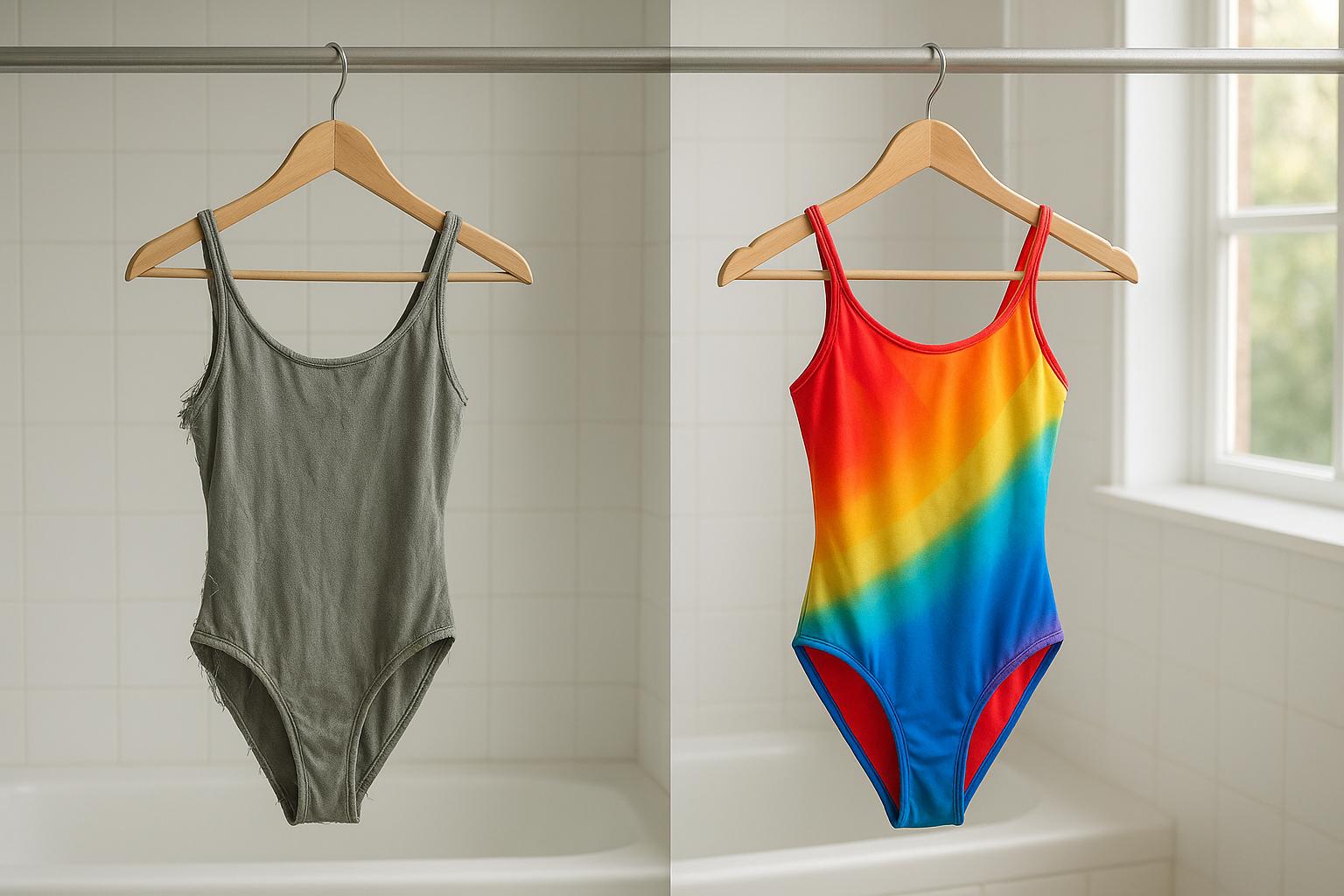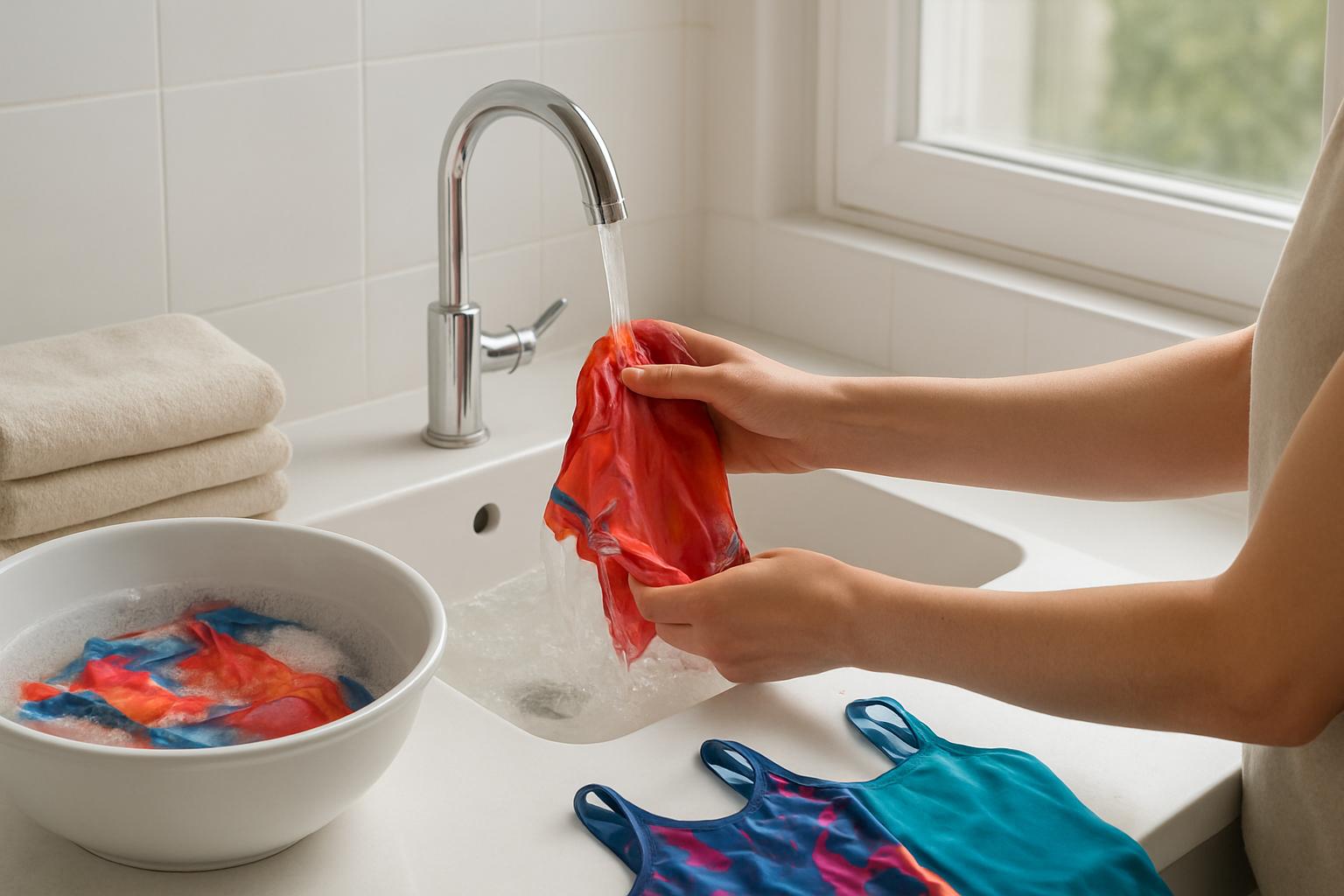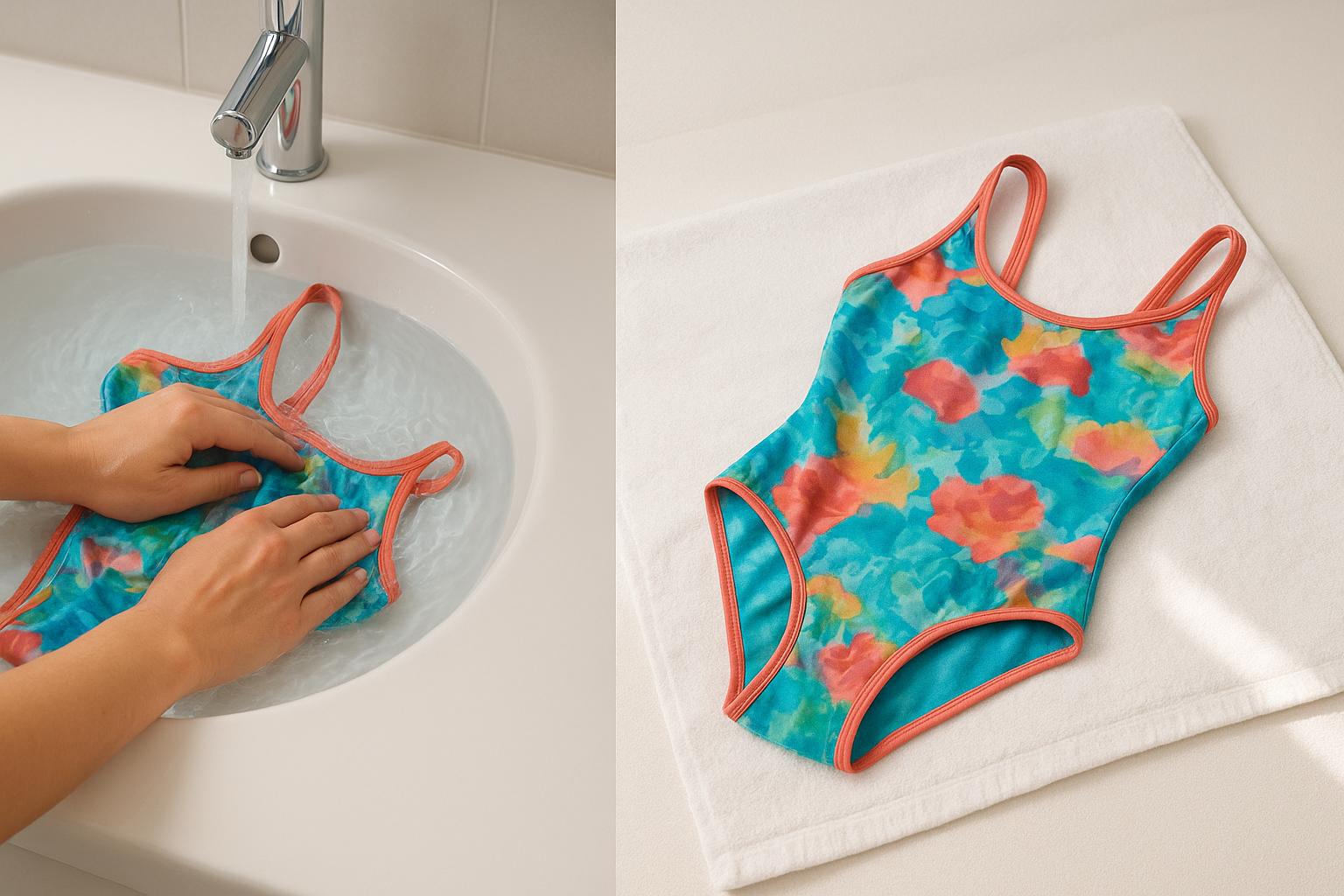How to clean swimsuits the right way—stop sagging, fading, and chlorine smell. Pro steps, sunscreen-stain fixes, and when to use professional wet cleaning.
How to Clean Swimsuits — Northridge’s Practical, Fabric-Safe Playbook
If your suits go dull, saggy, or chlorine-smelling after a few pool weekends, it’s not your imagination. How to Clean Swimsuits is precise work: swim fabrics—nylon, polyester, and elastane (spandex/LYCRA®)—take a beating from chlorine, salt, sunscreen, heat, and rough surfaces. Done right, a simple routine keeps color, snap, and fit for seasons—especially in the hot, dry San Fernando Valley.
Related reading: What Is Dry Cleaning • Dry Cleaning vs Wet Cleaning
The Short Version: What Matters Most
- Rinse immediately in cool, fresh water after every swim—pool, ocean, lake, or hot tub—to slow fiber damage and odor.
• Hand-wash with a gentle delicates detergent; avoid washer and dryer. Never wring—towel-roll blot and dry flat in shade.
• Time sunscreen (15 minutes before suiting up) and choose formulas wisely; some avobenzone sunscreens can rust-stain fabrics in hard water.
• Limit hot-tub exposure. Heat + chlorine = accelerated elastic breakdown. Keep a separate “spa suit.”
• For frequent pool use, choose polyester-rich or chlorine-resistant suits over high-spandex fashion blends.

Why Swimsuits Fail (and How to Stop It)
Chlorine, Heat, and Elastane Don’t Get Along
Chlorine chemically attacks elastane; heat speeds it up—especially in hot tubs. Once those fibers fatigue, you see baggy bottoms, slack straps, and “grin-through.” Keeping suits out of excess heat and rinsing right away slows the chemistry that eats elasticity.
Sunscreen Isn’t Harmless to Fabric
Oily UV filters cling; avobenzone can react with iron in hard water, creating orange/rust stains (worse on synthetics). Prevention beats heroics: apply, let set, then suit up; when stains happen, treat like rust—not grease.
Rough Surfaces and Sand Abrade the Knit
Pool decks and rock edges fuzz fabric; sitting on concrete accelerates pilling. Sit on a towel; rinse sand immediately so it doesn’t grind into fibers while drying.
Exact, Professional Routine (What We Advise Our Customers)
Right After You Swim (Pool, Ocean, or Hot Tub)
Rinse for 30–60 seconds under cool running water to remove chlorine, salt, and sunscreen. Gently press water out—don’t twist. Transport in a breathable bag, not sealed plastic.
At Home the Same Day
Fill a clean sink with cool water and a small dose of delicates-safe detergent—no bleach, no softeners. Soak 15–30 minutes, lightly swishing to reach seams and elastics. Rinse until water runs clear. Don’t wring: lay flat on a towel, roll, press to blot, then dry flat out of sun.
What to Avoid—Non-Negotiables
No washer/dryer for fashion/fitness suits (hand-wash is safer). If you must machine-wash: mesh bag, cold delicate, no spin; carry to a towel and blot. No bleach, no fabric softener, and no sun-baking to dry.
Sunscreen Stains: Prevention and Removal
Prevent: apply sunscreen ~15 minutes before your suit goes on so oils migrate less. Why they turn orange: avobenzone can bind iron in hard water, leaving rust-like stains. Treat like rust, not grease: use a fabric-safe rust remover (test first), then hand-wash and rinse thoroughly.
Pro move: If your tap water is hard, keep a jug of distilled water for final rinses of light suits; it cuts the mineral/avobenzone interaction.
Pool-Rats vs Beach-Days: Choose the Right Fabric
Pool daily? Polyester-rich or chlorine-resistant lines hold shape and color longer than high-spandex blends (trade-off: firmer feel).
Beach-first, fashion-forward? Expect more spandex for stretch—be diligent with rinsing and shade drying.
Hot-tub rule: High elastane + hot, chlorinated water = early failure. Keep an inexpensive “spa suit” and rinse immediately after soaking.
Sand, Salt, and Odor: Targeted Fixes
- Sand in the lining: Soak 10–15 minutes, massage fabric under water; for stubborn grains, let dry and gently shake out or use a cool hairdryer to lift particles.
• Persistent chlorine smell: After hand-wash, add a brief second soak in cool water with a teaspoon of delicates detergent or a rinse aid for synthetics; rinse again.
• Ocean stink: Salt is hygroscopic; rinse ASAP and keep airflow up during drying to prevent must.

Household Shortcuts That Ruin Suits (and What to Do Instead)
Shortcut: Throwing suits in with towels and jeans. Result: pilling and snags. Instead: wash solo or with delicates only—mesh bag if you must machine-wash.
Shortcut: Hanging by straps on a sunny balcony. Result: stretched straps and faded color. Instead: dry flat in shade or on a wide rack.
Shortcut: Wringing “to speed it up.” Result: distorted leg openings and thin spots. Instead: towel-roll blot.
The Northridge Reality: Heat, Dust, and Traffic
Valley summers bake chlorine/sunscreen into fabric, and hot-car storage after a pool day near CSUN or a community center sets odor. Don’t toss a wet suit in a trunk; quick-rinse and let it breathe on the way home. Rotate two or three suits so each dries fully between uses—elastic lasts longer.
Kids, Teams, and Frequent Swimmers: A Maintenance Cadence
After every wear: Rinse immediately; lay flat in shade.
Every 2–4 wears (or after sunscreen-heavy beach days): Hand-wash with delicates detergent; towel-blot; dry flat in shade.
Monthly (heavy pool users): Inspect for thinning at seat/underarms; if the knit shows grid lines or shines, retire it to “hot-tub duty” and buy a polyester-rich replacement.

Specialty Notes by Fabric & Construction
Polyester blends (incl. Endurance+): Best chlorine resistance; still handle gently—hand-wash and shade dry.
Nylon/elastane (most fashion suits): Great stretch/hand; vulnerable to chlorine/heat; religious rinsing and shade drying required.
Ribbed, textured, crochet overlays: Snag-prone—wash solo, mesh bag if machine-washed at all, and dry flat on a smooth towel.
Hardware, zips, cups: Rinse thoroughly around metal/plastic to avoid deposits; remove pads before washing if possible and reshape while damp.
When to Bring Suits to Us (and What We Do)
Bring swimsuits when sunscreen stains survive a proper hand-wash, chlorine odor lingers, seams need repair, or you have a post-beach family pile. We use professional wet cleaning with neutral pH and tension drying that resets fabric without wrecking the knit; alterations re-stitch straps/seams; we return everything flat-dried and ready.
Straight Answers to Common Questions
Can I machine-wash swimsuits if I’m gentle? Hand-washing wins for longevity. If you must machine-wash, use a mesh bag, cold delicate, no spin, and air-dry flat in shade.
How soon do I need to rinse after swimming? As soon as possible. Even a quick rinse at the pool cuts chlorine/salt time in the knit and reduces odor.
Do I need special “swim” detergent? Not mandatory. A mild delicates detergent is fine—avoid bleach and softeners. The key is gentle chemistry plus thorough rinsing.
Why does my light suit get orange stains after washing? Likely avobenzone + iron in hard water. Treat as rust with a fabric-safe remover (test first), then rinse thoroughly.
Which fabric lasts longest for daily pool use? Polyester-rich or chlorine-resistant fabrics outlast high-spandex blends.
Is sun-drying OK if I’m in a hurry? Direct sun accelerates fading and fiber fatigue. Shade or indoor airflow is safer; towel-blot first to speed drying.
Can you fix stretched-out elastic? Once elastane degrades, it won’t “snap back.” Minor seam take-ins can help; otherwise replace the suit and keep a separate hot-tub set.
Local Edge—and a Simple Next Step
Between triple-digit heat waves, long sunny afternoons, and hard-water pockets across the Valley, suits here age faster than coastal microclimates. The routine above—immediate rinse, gentle hand-wash, shade-dry, sunscreen timing, and fabric choice—directly counters those stressors. Short on time? Book pickup; we’ll wet-clean a household’s beach pile, press your event wear, and return everything before the next pool day.
Explore more services: Professional Dry Cleaning Services • Bridal & Groom Services
Follow our work: 👉 Our Instagram Laundry Page
